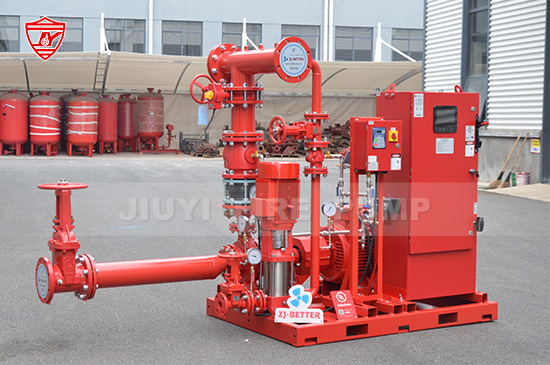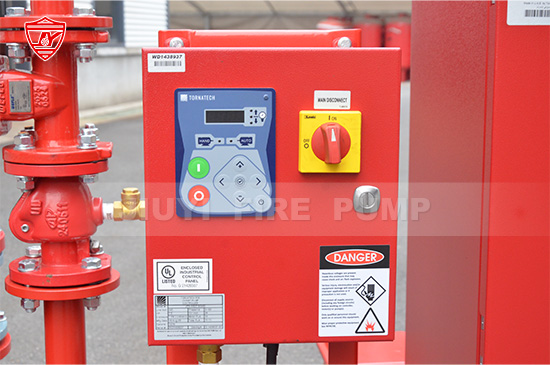Motor efficiency is one of the most critical performance indicators in any UL fire pump set. A fire pump is the heart of a building’s fire protection system, and the motor is the core component that drives it. If the motor cannot deliver the required power efficiently, the entire system’s reliability is at risk. Poor motor efficiency leads to higher energy consumption, frequent overheating, increased mechanical stress, and ultimately reduced pump output during fire emergencies.
This article provides a complete, practical, and engineer-friendly guide on how to check motor efficiency in UL fire pump sets. Whether you are a fire protection consultant, an EPC contractor, a facility maintenance team, or a building owner, understanding the process helps ensure compliance with UL standards and NFPA 20, maintain long-term reliability, and reduce operating costs.

UL fire pump sets follow strict guidelines to ensure they run reliably under emergency conditions. Motor efficiency directly affects:
An efficient motor ensures stable rpm and sufficient torque. If the motor efficiency is low, the pump may fail to deliver rated flow and pressure, affecting the fire suppression system’s overall effectiveness.
Fire pumps may run during periodic testing. A low-efficiency motor requires more electricity to produce the same output, increasing operational cost for the facility.
Heat is the number one enemy of electric motors. High efficiency means less wasted energy in the form of heat, resulting in longer insulation life and fewer failures.
UL 448 and NFPA 20 specify expected performance criteria. A motor that cannot maintain efficiency may fail compliance checks and compromise system certification.
To check motor efficiency, you must first understand the factors that affect it:
UL fire pump motors are designed to operate within a specific voltage tolerance. A voltage imbalance greater than 1% can reduce efficiency and cause overheating.
A low power factor indicates that the motor is drawing more current than necessary. Fire pump motors require a stable and healthy power factor to ensure efficient performance.
Electric motors reach their best efficiency at around 75–100% of rated load. If the pump system is poorly designed or has oversized components, efficiency drops significantly.
Ambient temperature, ventilation, and dust buildup all impact the motor’s ability to dissipate heat, which directly affects efficiency.
Misalignment between pump and motor shaft increases friction losses, consuming unnecessary energy and lowering efficiency.
Over time, insulation degrades, bearing friction increases, and rotor performance may weaken. Regular efficiency checks identify these problems early.
Testing motor efficiency involves both electrical and mechanical evaluation. The following method aligns with industry practices, NFPA 20 recommendations, and UL fire pump performance standards.
Before any measurement begins, gather the following information from the motor nameplate:
Rated horsepower
Voltage
Full-load current
Rated rpm
Efficiency rating
Power factor
This information establishes the baseline for comparison during testing. UL-listed motors include additional safety compliance markings indicating they have passed specific performance tests.
Use a calibrated electrical meter to measure:
Line-to-line voltage
Voltage imbalance
Phase current
Current imbalance
Keep voltage imbalance under 1% and current imbalance under 10% to maintain optimal efficiency.
A fire pump motor facing voltage imbalance will draw excess current, generate heat, and operate inefficiently.
Evaluate the motor’s power factor using a power analyzer. Fire pump motors typically operate with a power factor between 0.8 and 0.9 under load.
A lower power factor indicates inefficiency and can reveal underlying problems such as:
Winding faults
Undervoltage
Mechanical overload
Monitoring power factor regularly helps identify hidden performance issues.
Using the formula:
Input Power (kW) = √3 × Voltage × Current × Power Factor ÷ 1000
This value is essential for calculating actual efficiency.
To assess motor efficiency, you must know how much work the pump is performing. Conduct a pump performance test following UL and NFPA 20 requirements, measuring:
Flow rate
Pump discharge pressure
Suction pressure
Net pressure
Horsepower demand
This test reveals how much mechanical load is applied to the motor.
Shaft power (the mechanical power delivered by the motor to the pump) is calculated from pump hydraulic data:
Shaft Power (kW) = (Flow × Pressure × Constant) ÷ Motor Efficiency Factor
The formula varies depending on units used, but this step helps determine the actual load percentage.
Finally, calculate efficiency using:
Motor Efficiency (%) = (Shaft Power Output ÷ Motor Input Power) × 100
Compare the result with the motor nameplate efficiency:
If measured efficiency is close to rated efficiency → motor is healthy.
If significantly lower → investigate electrical and mechanical causes.

While basic calculations provide a good estimate, advanced methods offer higher accuracy, especially for large UL fire pump motors.
A dynamometer directly measures motor torque and output power. This provides the most accurate efficiency measurement but is usually performed in controlled factory or service center environments.
MCA tests winding resistance, phase balance, inductance, and insulation condition. It detects internal issues that reduce efficiency, such as:
Winding degradation
Rotor bar defects
Internal short circuits
This test is non-invasive and highly useful for preventive maintenance.
Using an infrared thermal camera helps identify:
Hot spots
Poor ventilation
Bearing overheating
Unbalanced phase loads
Excessive heat correlates with reduced efficiency and impending failure.
Misalignment, imbalance, or deteriorating bearings create vibration that increases mechanical losses. Measuring vibration levels helps maintain motor efficiency and prevent unexpected breakdowns.
If the motor fails to meet its expected efficiency, the root cause is often one of the following:
This is one of the most common efficiency killers.
Causes friction and reduces shaft speed.
Increases load demand on the motor.
Generates excessive vibration and energy loss.
An undersized motor overheats; an oversized motor wastes energy.
Reduces output power capability and increases electrical losses.
Understanding these causes helps technicians correct problems before they worsen.
For UL fire pump sets, recommended intervals include:
Monthly:
Basic electrical readings during routine pump testing.
Quarterly:
Power factor, current balance, and motor temperature checks.
Annually:
Full pump performance test plus motor efficiency assessment.
Every 3–5 years:
Advanced diagnostics such as MCA, vibration analysis, and thermal imaging.
Regular monitoring ensures long-term reliability and compliance with NFPA 20.
Large facilities may require voltage regulators or dedicated transformers.
Clean dust regularly, check air passages, and maintain ambient temperature.
Use laser alignment tools for best results.
Follow manufacturer intervals and use the correct lubrication type.
This ensures the motor remains capable of delivering rated performance.
Do not delay repairs when efficiency drops.
Certified components guarantee stable performance under fire conditions.

Checking motor efficiency in UL fire pump sets is essential for maintaining reliable fire protection performance, ensuring compliance, and extending the lifespan of critical equipment. By following the steps outlined in this guide—measuring electrical input, evaluating pump output, calculating efficiency, and performing advanced diagnostics—you can accurately assess how well your fire pump motor is performing.
A fire pump system is only as strong as its weakest component. Regular monitoring, proper maintenance practices, and adherence to UL and NFPA guidance ensure that your fire protection system is always ready when it matters most.